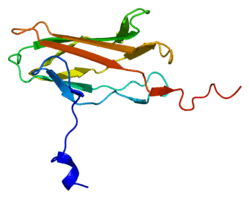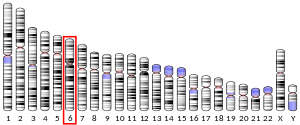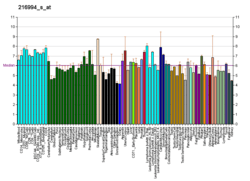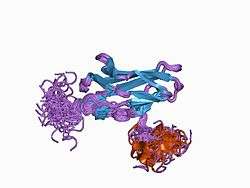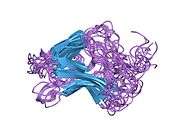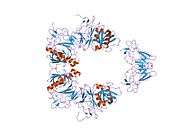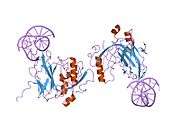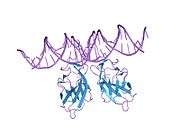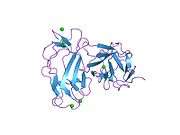RUNX2
Runt-related transcription factor 2 (RUNX2) also known as core-binding factor subunit alpha-1 (CBF-alpha-1) is a protein that in humans is encoded by the RUNX2 gene. RUNX2 is a key transcription factor associated with osteoblast differentiation.
Function
This protein is a member of the RUNX family of transcription factors and has a Runt DNA-binding domain. It is essential for osteoblastic differentiation and skeletal morphogenesis and acts as a scaffold for nucleic acids and regulatory factors involved in skeletal gene expression. The protein can bind DNA both as a monomer or, with more affinity, as a subunit of a heterodimeric complex. Transcript variants of the gene that encode different protein isoforms result from the use of alternate promoters as well as alternate splicing.[5]
Differences in RUNX2 are hypothesized to be the cause of the skeletal differences between modern humans and early humans such as Neanderthals. These differences include a different shape of the skull, a bell-shaped chest in Neanderthals, etc.[6]
The binding interactions of RUNX2 change as cells go through mitosis, with binding affinity increasing as chromosomes condense and then decreasing through subsequent mitotic phases. The increased residence of RUNX2 at mitotic chromosomes may reflect its epigenetic function in "bookmarking" of target genes in cancer cells.[7]
Pathology
Mutations in Cbfa1/Runx2 are associated with the disease Cleidocranial dysostosis.
Co-factors
Runx proteins represent the alpha DNA binding subunit of a heteromeric protein complex that also includes the non-DNA binding beta-subunit which increases the DNA binding affinity of the alpha subunit. In addition, there is a large cohort of regulatory proteins that bind to the C-terminus of Runx2 to modify its transcriptional function. [8]
Interactions
RUNX2 has been shown to interact with:
miR-133 directly inhibits Runx2.[18]
See also
References
- 1 2 3 GRCh38: Ensembl release 89: ENSG00000124813 - Ensembl, May 2017
- 1 2 3 GRCm38: Ensembl release 89: ENSMUSG00000039153 - Ensembl, May 2017
- ↑ "Human PubMed Reference:".
- ↑ "Mouse PubMed Reference:".
- ↑ "Entrez Gene: RUNX2 runt-related transcription factor 2".
- ↑ Green RE, Krause J, Briggs AW, Maricic T, Stenzel U, Kircher M, Patterson N, Li H, Zhai W, Fritz MH, Hansen NF, Durand EY, Malaspinas AS, Jensen JD, Marques-Bonet T, Alkan C, Prüfer K, Meyer M, Burbano HA, Good JM, Schultz R, Aximu-Petri A, Butthof A, Höber B, Höffner B, Siegemund M, Weihmann A, Nusbaum C, Lander ES, Russ C, Novod N, Affourtit J, Egholm M, Verna C, Rudan P, Brajkovic D, Kucan Z, Gusic I, Doronichev VB, Golovanova LV, Lalueza-Fox C, de la Rasilla M, Fortea J, Rosas A, Schmitz RW, Johnson PL, Eichler EE, Falush D, Birney E, Mullikin JC, Slatkin M, Nielsen R, Kelso J, Lachmann M, Reich D, Pääbo S (May 2010). "A draft sequence of the Neandertal genome". Science. 328 (5979): 710–22. PMID 20448178. doi:10.1126/science.1188021.
- ↑ Pockwinse SM, Kota KP, Quaresma AJ, Imbalzano AN, Lian JB, van Wijnen AJ, Stein JL, Stein GS, Nickerson JA (May 2011). "Live cell imaging of the cancer-related transcription factor RUNX2 during mitotic progression". Journal of Cellular Physiology. 226 (5): 1383–9. PMC 3050607
 . PMID 20945391. doi:10.1002/jcp.22465.
. PMID 20945391. doi:10.1002/jcp.22465. - ↑ Lian JB, Javed A, Zaidi SK, Lengner C, Montecino M, van Wijnen AJ, Stein JL, Stein GS (2004). "Regulatory controls for osteoblast growth and differentiation: role of Runx/Cbfa/AML factors". Critical Reviews in Eukaryotic Gene Expression. 14 (1-2): 1–41. PMID 15104525.
- ↑ Baniwal SK, Khalid O, Sir D, Buchanan G, Coetzee GA, Frenkel B (Aug 2009). "Repression of Runx2 by androgen receptor (AR) in osteoblasts and prostate cancer cells: AR binds Runx2 and abrogates its recruitment to DNA". Molecular Endocrinology. 23 (8): 1203–14. PMC 2718746
 . PMID 19389811. doi:10.1210/me.2008-0470.
. PMID 19389811. doi:10.1210/me.2008-0470. - ↑ Khalid O, Baniwal SK, Purcell DJ, Leclerc N, Gabet Y, Stallcup MR, Coetzee GA, Frenkel B (Dec 2008). "Modulation of Runx2 activity by estrogen receptor-alpha: implications for osteoporosis and breast cancer". Endocrinology. 149 (12): 5984–95. PMC 2613062
 . PMID 18755791. doi:10.1210/en.2008-0680.
. PMID 18755791. doi:10.1210/en.2008-0680. - 1 2 Hess J, Porte D, Munz C, Angel P (Jun 2001). "AP-1 and Cbfa/runt physically interact and regulate parathyroid hormone-dependent MMP13 expression in osteoblasts through a new osteoblast-specific element 2/AP-1 composite element". The Journal of Biological Chemistry. 276 (23): 20029–38. PMID 11274169. doi:10.1074/jbc.M010601200.
- 1 2 D'Alonzo RC, Selvamurugan N, Karsenty G, Partridge NC (Jan 2002). "Physical interaction of the activator protein-1 factors c-Fos and c-Jun with Cbfa1 for collagenase-3 promoter activation". The Journal of Biological Chemistry. 277 (1): 816–22. PMID 11641401. doi:10.1074/jbc.M107082200.
- ↑ Schroeder TM, Kahler RA, Li X, Westendorf JJ (Oct 2004). "Histone deacetylase 3 interacts with runx2 to repress the osteocalcin promoter and regulate osteoblast differentiation". The Journal of Biological Chemistry. 279 (40): 41998–2007. PMID 15292260. doi:10.1074/jbc.M403702200.
- ↑ Pelletier N, Champagne N, Stifani S, Yang XJ (Apr 2002). "MOZ and MORF histone acetyltransferases interact with the Runt-domain transcription factor Runx2". Oncogene. 21 (17): 2729–40. PMID 11965546. doi:10.1038/sj.onc.1205367.
- 1 2 Zhang YW, Yasui N, Ito K, Huang G, Fujii M, Hanai J, Nogami H, Ochi T, Miyazono K, Ito Y (Sep 2000). "A RUNX2/PEBP2alpha A/CBFA1 mutation displaying impaired transactivation and Smad interaction in cleidocranial dysplasia". Proceedings of the National Academy of Sciences of the United States of America. 97 (19): 10549–54. PMC 27062
 . PMID 10962029. doi:10.1073/pnas.180309597.
. PMID 10962029. doi:10.1073/pnas.180309597. - 1 2 Hanai J, Chen LF, Kanno T, Ohtani-Fujita N, Kim WY, Guo WH, Imamura T, Ishidou Y, Fukuchi M, Shi MJ, Stavnezer J, Kawabata M, Miyazono K, Ito Y (Oct 1999). "Interaction and functional cooperation of PEBP2/CBF with Smads. Synergistic induction of the immunoglobulin germline Calpha promoter". The Journal of Biological Chemistry. 274 (44): 31577–82. PMID 10531362. doi:10.1074/jbc.274.44.31577.
- ↑ Li X, Huang M, Zheng H, Wang Y, Ren F, Shang Y, Zhai Y, Irwin DM, Shi Y, Chen D, Chang Z (Jun 2008). "CHIP promotes Runx2 degradation and negatively regulates osteoblast differentiation". The Journal of Cell Biology. 181 (6): 959–72. PMC 2426947
 . PMID 18541707. doi:10.1083/jcb.200711044.
. PMID 18541707. doi:10.1083/jcb.200711044. - ↑ Li Z, Hassan MQ, Volinia S, van Wijnen AJ, Stein JL, Croce CM, Lian JB, Stein GS (Sep 2008). "A microRNA signature for a BMP2-induced osteoblast lineage commitment program". Proceedings of the National Academy of Sciences of the United States of America. 105 (37): 13906–11. PMC 2544552
 . PMID 18784367. doi:10.1073/pnas.0804438105.
. PMID 18784367. doi:10.1073/pnas.0804438105.
Further reading
- Otto F, Kanegane H, Mundlos S (Mar 2002). "Mutations in the RUNX2 gene in patients with cleidocranial dysplasia". Human Mutation. 19 (3): 209–16. PMID 11857736. doi:10.1002/humu.10043.
- Komori T (Mar 2002). "[Cbfa1/Runx2, an essential transcription factor for the regulation of osteoblast differentiation]". Nihon Rinsho. Japanese Journal of Clinical Medicine. 60 Suppl 3: 91–7. PMID 11979975.
- Stock M, Otto F (Jun 2005). "Control of RUNX2 isoform expression: the role of promoters and enhancers". Journal of Cellular Biochemistry. 95 (3): 506–17. PMID 15838892. doi:10.1002/jcb.20471.
- Blyth K, Cameron ER, Neil JC (May 2005). "The RUNX genes: gain or loss of function in cancer". Nature Reviews. Cancer. 5 (5): 376–87. PMID 15864279. doi:10.1038/nrc1607.
- Schroeder TM, Jensen ED, Westendorf JJ (Sep 2005). "Runx2: a master organizer of gene transcription in developing and maturing osteoblasts". Birth Defects Research. Part C, Embryo Today. 75 (3): 213–25. PMID 16187316. doi:10.1002/bdrc.20043.
- Frenkel B, Hong A, Baniwal SK, Coetzee GA, Ohlsson C, Khalid O, Gabet Y (Aug 2010). "Regulation of adult bone turnover by sex steroids". Journal of Cellular Physiology. 224 (2): 305–10. PMID 20432458. doi:10.1002/jcp.22159.
External links
- GeneReviews/NCBI/NIH/UW entry on Cleidocranial Dysplasia
- Runx2 protein at the US National Library of Medicine Medical Subject Headings (MeSH)
